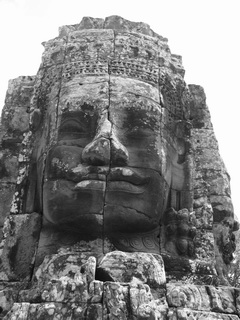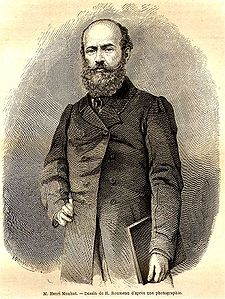
Picture taken on my visit to Bayon Temple, Angkor
For most westerners, “Angkor” or “Angkor Wat” conjures images of a lone European explorer hacking his way through the thick jungle undergrowth in Indochina and stumbling across some lost ruins — giant blocks of carved stone strangled by giant vines and trampled underfoot by the giant roots of giant trees... and the rock formations green with jungle moss, turn out to be the remains of a temple complex... in fact, nothing less than one of the “Wonders of the Ancient World.”
That never happened, but like most westerners, I didn’t know any better, until I visited Angkor for myself in 2005.
The part about a run-down Angkor succumbing to nature and being in a serious state of disrepair is true, but Angkor was never lost. The location of every single Angkor site on the tourist itinerary today has always been known to the Khmers, who had never stopped worshiping at their altars and temples since Angkor’s heyday in the 10th century A.D.
As for Henri Mouhot, the mid-19th-century explorer supposedly responsible for “finding” or “discovering” or “rediscovering” a “lost” Angkor in the jungles? He never actually claimed that Angkor was “lost” or “rediscovered.” In fact, Mouhot acknowledged that Angkor had already been visited since the 16th century by several Europeans, such as António da Madalena in 1586, who was taken there by locals who brought him on trails and roads (already-charted territory) that led right up to these sites. Yet, somehow, this persistent myth about one of the “Great Wonders of the Ancient World” being lost and found by a European explorer lingers on and is still being perpetuated today:
- Discovery Channel recently aired a Beyond Borders episode on Cambodia, where its host described just such a scenario of a European explorer hacking through the jungles to stumble upon the ruins of Angkor, which supposedly had been “lost” for centuries.
- Western school books still credit “French explorer Mouhot” with the discovery of Angkor.
- In movies such as Indiana Jones and Tomb Raider, Hollywood plays on lost-temple mythology, on images of lone Europeans stumbling upon lost and/or abandoned Angkor-like ruins in the jungles.
- Numerous websites still incorrectly state that Angkor was “lost” and rediscovered by Henri Mouhot, and they often don’t even know the difference between Angkor and Angkor Wat.
- Angkor Wat is widely referred to as an “Ancient Wonder” from some unknown era, despite the fact that it was built around the time of the High Middle Ages (1001–1300 A.D.) in Europe and we don’t exactly refer to the Tower of London (built in 1078 A.D.) as an “ancient wonder,” nor Notre Dame de Paris (built in 1160 A.D.) or any number of old European castles from that period.
FACTS: ANGKOR & ANGKOR WAT (they’re not the same thing!)
- Angkor was the capital of the Khmer empire, home of Khmer rulers, and a major center for culure, business and religion.
- The most famous temple building in Angkor is Angkor Wat, one of the largest temple structures in the world.
- Angkor first rose in the 800s, but most of the sites and buildings were established in the 1100s.
- Up to 1 million inhabitants lived in Angkor at the peak of the Khmer empire.
- Over population, drastic climate change and food shortages led to Angkor’s decline in the 1400s. In a weakened state by 1431, Angkor was conquered by invading armies and thereafter left in a state of decline (not abandonment) for centuries.
- From the 1500s onward, Angkor was visited by many westeners, mostly Spanish and Portguese missionaries, but also Japanese and Chinese travelers following in Zhou Daguan’s footsteps, many of them writing about and even sketching the buildings of Angkor.
It was never my intention to be iconoclastic, but I often got into serious trouble as a kid in school for having the audacity to ask my history teacher sincere questions, such as how Christopher Columbus could possibly have “discovered” America, if it was already populated by “Indians.” Stumped at my supposed insolence, she told me to shut up and made me stand in a corner, facing the wall. The only way I could make sense of it all, was that Christopher Columbus (and Amerigo Vespucci whom the continent is named after) had “discovered America for the Europeans,” because before that, they were in the dark about the existence of the continent. However, when it comes to Mouhot, this is a case where Eurocentrism and the Great-White-Man-Explorer Syndrome — Henri discovering a lost Angkor for the Europeans — cannot adequately explain how the fallacy came to be. There’s quite a bit more to the story.
To get to the bottom of how this shameless Eurocentric falsehood was established as common knowledge, we may need to explore not only the life of the Explorer who was incorrectly credited with “Angkor’s discovery,” but the stakes-and-claims mindset of his financial backers, the colonialist era in which he lived and the prevalent patronizing mindset of westerners in general.
Henri Mouhot

Henri Mouhot (May 15, 1826 — November 10, 1861) was a French naturalist and explorer, remembered mostly in connection to Angkor and incorrectly credited with its “discovery.” Born in Montbéliard, Doubs, France, near the Swiss border, Mouhot spent his childhood in Russia. As a young professor of philology, Mouhot spent at least 10 years of his life working as a language tutor in Russia. He traveled throughout Europe with his brother Charles, studying photographic techniques developed by Louis Daguerre. In 1856, he began devoting himself entirely to the study of Natural Science and that same year, he married the niece of Scottish explorer Mungo Park.
The newly married Mouhot may have had a lot to prove and live up to. One year later, upon reading The Kingdom and People of Siam by Sir James Bowring in 1857, Mouhot decided to travel to Indochina to undertake a series of botanical expeditions to collect new zoological specimens. His initial requests for grants and passage were rejected by French companies and the government of Napoleon III. However, the Royal Geographical Society and the Zoological Society of London lent him their support, and he set sail for Bangkok, via the British colony of Singapore.
Mouhot’s Expeditions and Death
In 1858, from his base in Bangkok, Mouhot made four journeys into the interior of Siam, Cambodia and Laos. Over a period of three years, he endured extreme hardships and fended off wild animals to explore some previously uncharted jungle territory.
On his first expedition, he visited Ayutthaya, the former capital of Siam (already-charted territory) and gathered an extensive collection of insects, terrestrial and river shells, and sent them on to England.
In January 1860, at the end of his second and longest journey, he reached Angkor (already-charted territory). Angkor was an entire complex that encompassed an area of more than 400 km² (154 sq. miles) and comprised numerous sites with terraces, pools, moated cities, palaces and temples, the most famous of which was Angkor Wat. (In other words, the huge Angkor Wat temple was just one of many temples in Angkor.) Mouhot recorded his visit to Angkor in his travel journals, which included three weeks of detailed observations. These journals and illustrations were later incorporated into books that were published posthumously.
On his fourth expedition to the jungles of Laos, Mouhot died of a malarial fever. He had been visiting Luang Prabang, capital of the Lan Xang kingdom — one of three kingdoms that eventually merged into an earlier version of modern-day Laos — and was under the patronage of the king. Two of his servants buried him near a French mission in Naphan, by the banks of the Nam Khan river. Mouhot’s favorite servant, Phrai, transported all of Mouhot’s journals and specimens back to Bangkok, from where they were shipped onward to Europe.
Henri Mouhot did not discover Angkor
Mouhot mentions in his journals that his contemporary, Father Bouillevaux, had reported on a journey to Angkor Wat and the other Khmer temples together with some other western explorers and missionaries, and that this had taken place at least five years prior to Mouhot’s visit.
The location and existence of the entire series of Angkor sites had always been known to the Khmers — Mouhot was certainly not the first westerner to visit Angkor. By the time Mouhot reached Angkor in 1860, it had already been visited by several westerners since the 16th century:
- In 1586, Portuguese friar Antonio da Madalena visited Angkor Wat and published the accounts of his trip with the help of a Portuguese trader by the name of Diogo do Couto. De Magdalena had traveled along roads and trails leading to villages between and around the Angkor sites, probably what is modern-day Siem Reap.
- In 1601, Bortolome de Argensola wrote about his visit to the Angkor area, describing it as being in a state of disrepair and succombing to the jungle (Angkor had been temporarily vacated due to wars).
- In the 1600s, numerous Spanish and Portuguese missionaries visited Angkor.
- In 1668, Father Chevreuil wrote of Angkor Wat as a temple renowned amongst the people of Southeast Asia.
- In 1789, the first translation of the memoir of Zhou Daguan (1266–1346 AD, Chinese diplomat under Temür Khan who spent one year in Angkor) was published in Paris, and from 1850 onward, there was a regular flow of visitors to Angkor Wat.
- In 1857, Father Charles-Emile Bouillevaux, a French missionary based in Battambang, published his accounts of visiting Angkor in his book: Travels in Indochina 1848–1856 (Voyage dans l’Indochine, 1848-1856).
How the Posthumous Myth Began
Mouhot’s journals were shipped to Europe after his death. His writings were collected and published posthumously in a book called Travels in Siam, Cambodia and Laos, and began to popularize Angkor in the West. Perhaps none of the previous European visitors to Angkor wrote as evocatively as Mouhot, who included interesting and detailed sketches. His assumptive statements and flamboyant theories were arrogant by any standards, but found a receptive audience among colonial-era Europeans, capturing their imaginations.
Mouhot compared Angkor to the pyramids, for it was popular in the West at that time to ascribe the origin of all civilization to the Middle East. For example, he described the Buddha heads at the gateways to Angkor Thom as “four immense heads in the Egyptian style,” and he wrote of Angkor:
“One of these temples — a rival to that of Solomon, and erected by some ancient Michael Angelo — might take an honorable place beside our most beautiful buildings. It is grander than anything left to us by Greece or Rome, and presents a sad contrast to the state of barbarism in which the nation is now plunged.”
It didn’t exactly help that the locals whom Mouhot met attributed the buildings around them to be the work of “god kings” and “giants.” But Mouhot failed to look deeper into their culture of mythology and rushed to fill in the gaps, erroneously claiming that Angkor was the work of an earlier civilization than the Khmer. Ever the superior European, Mouhot assumed that the authors of such grandeur were of a disappeared race and errantly dated the creation of Angkor back to over two millennia, to around the same era as Roman Empire. For although the very same civilization which had built Angkor was alive and right before his eyes, Mouhot considered their existence to be a “state of barbarism” and never entertained the notion that the Khmer could be civilized or enlightened enough to have built it themselves:
“At Ongcor, there are ...ruins of such grandeur... that, at the first view, one is filled with profound admiration, and cannot but ask what has become of this powerful race, so civilized, so enlightened, the authors of these gigantic works.”
Mouhot concluded that Angkor must have been built by some other enlightened civilization from a long, long ago, and not the “barbaric” Khmers before him. It was calculatedly vague and carefully worded quotations such as these that gave rise to the popular misconception that Mouhot had “found” or “discovered” the “abandoned ruins” of a “lost civilisation.”
The Royal Geographical Society and the Zoological Society, organizations with vested interests in announcing new finds in a very competitive age of scientific discovery, may likely have encouraged the rumor that Mouhot — whom they had sponsored to chart mountains and rivers of Indochina and catalog new species — had “discovered” Angkor. It was the height of the Victorian Era, the golden age of the British Empire, when the prevalent opinion among Europeans was that barbaric pagans whose lives were not as meaningful should be Christianized. If Christopher Columbus had “discovered America” when it was already populated, it was no gigantic leap of logic that one of their “own,” Henri Mouhot — who was married to the niece of the great Scottish explorer Mungo Park — had “discovered Angkor.”
The truth about Angkor
Mouhot and the various British scientific societies were wrong on all counts. The true history of Angkor and Angkor Wat was later pieced together from the book, The Customs of Cambodia, written by Temur Khan’s envoy to Cambodia in 1295-1296, Zhou Daguan, and from stylistic and epigraphic evidence accumulated during the subsequent clearing and restoration work carried out across the whole Angkor site. It is has now been established that the dates of Angkor’s habitation were from the early 9th to the early 15th centuries.
Angkor had been built and fully inhabited only 300 years earlier, by the very same race of people standing right before Mouhot, but he was too busy being superior to believe it.
Mouhot’s Legacy
Mouhot was buried near a French mission in Naphan, by the banks of the Nam Khan river. A modest monument was erected over his grave in 1867, under the orders of French commander Doudart de Lagrée, who gave him this eulogy:
“We found everywhere the memory of our compatriot who, by the uprightness of his character and his natural benevolence, had acquired the regard and the affection of the natives.”
The monument was destroyed by the overflow of the river Nam Khan. It was replaced in 1887 by a more durable crypt monument, and a maisonnette was built nearby to house and feed visitors to the white shrine. Some restoration work was done on the tomb in 1951 by the EFEO (Ecole Française d’Extrème Orient — The French School of the Far East).
In an ironic twist of fate, Mouhot’s tomb was consumed by the jungle and lost for 40 years, until it was accidentally rediscovered in 1990. His birth town of Montbeliard then helped with its restoration that same year. A new plaque on one end of the crypt commemorates the rediscovery of Mouhot’s burial place in 1990.
The popularity of Angkor generated by Mouhot’s writings, led to popular support for a major French role in its study and preservation. The French carried out the majority of research work on Angkor until recently.
Some have argued that Mouhot may have been a tool for French colonialism and the annexation of territories that followed shortly after his death. To be fair however, although Mouhot had displayed the traits of a Euro-supremacist like so many of his contemporaries, he did not seem to be a hardcore colonialist, for he occasionally doubted the beneficial effects of European colonization:
“Will the present movement of the nations of Europe towards the East result in good by introducing into these lands the blessings of our civilization? Or shall we, as blind instruments of boundless ambition, come hither as a scourge, to add to their present miseries?”
However, borne of the posthumous misattribution to Henri Mouhot discovering Angkor, the idea that the Angkor ruins were lost and (re)discovered by Europeans lingers on.
Mouhot’s writings — his travel journals — are immortalized in Voyage dans les royaumes de Siam, de Cambodge, de Laos et autres parties centrales de l’Indochine (published 1863, 1864) — English title: Travels in the Central Parts of Indo-China, Cambodia and Laos During the Years 1858,1859, and 1860.
References:
- Encyclopedia Britannica
- Angkor Guide, published in Siem Reap by the Cambodian Ministry of Information
- Cambodia History, Khmer History, published by the Cambodian Ministry of Information
- Angkor History, published by the Cambodian Ministry of Information
- The Siem Reap Angkor Visitors Guide (quarterly—March-May 2005), Canby publications
(www.canbypublications.com) - University of California Irvine, Cambodian Students Organization, Knowledge Section
[online: http://spirit.dos.uci.edu/cambo/ retreived August 2005] - Ron Emmonís Biographies (http://ronemmons.com/biographies/mouhot/)
- The Forgotten Crypt of Henri Mouhot (1826-1861) [www.angkor.com/hd.shtml Last accessed 2005]
- German Wikipedia: http://de.wikipedia.org/wiki/Henri_Mouhot
- Henri Mouhotís diary; Travels in the Central Parts of Siam, Cambodia and Laos During the Years 1858-61
- Angkor Wat Online [online: http://angkor.wat.online.fr/dec-henri_mouhot.htm retrieved august 2005]
- Bryson, 2003, A Short History of Nearly Everything, chap. 6, ISBN 0-552-15174-2
- Travels in Siam, Cambodia, Laos, and Annam - Henri Mouhot, M. Mouhot (ISBN 974-8434-03-6)
- Travels in Siam, Cambodia and Laos, 1858-1860 - Henri Mouhot, Michael Smithies
(ISBN 0-19-588614-3) - Travels in the Central Parts of Indo-China (Siam), Cambodia, and Laos During the Years 1858, 1859, and 1860 -- Mouhot, M. Henri (Illustrated by Profusely illus in b/w) (ISBN 974-8495-11-6)
Helpful links:
- www.angkorwat.org/html/L2225.html [Last accessed: 2005]
- Short biography (in French)
- www.kh.refer.org/cbodg_ct/decouvert_kh/culture_kh/livres/mouhot.htm (in French) [Last accessed: 2005]
- www.insecula.com/contact/A010818.html (in French) [Last accessed: 2005]
- www.angkor.com/hd.shtml
© Zak Keith, 2005






